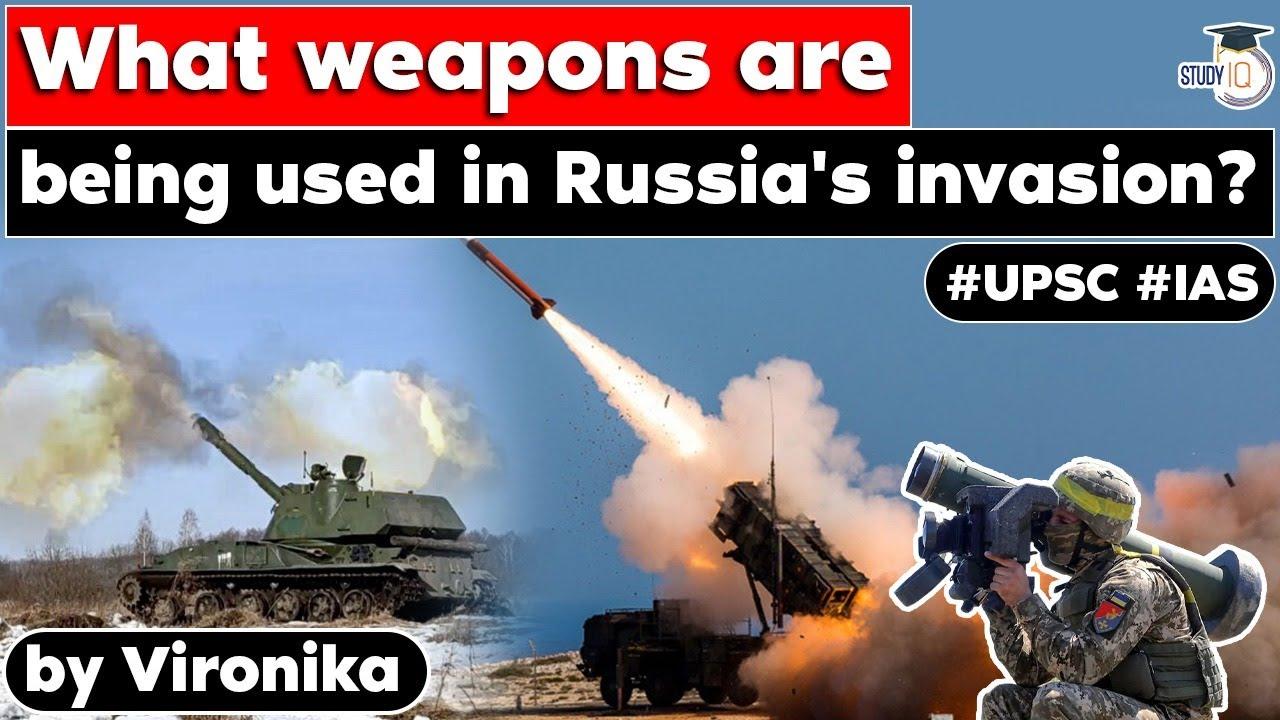Table of Contents
- Russia’s invasion of Ukraine began on February 24 and is evidently the largest military assault by one European state on another since World War Two.
- According to the Western countries the initial battle plan was aimed at swiftly toppling Ukraine’s government in Kyiv, but even after more than two weeks of military assault, Russia has control of only one Ukrainian city so far – the southern Dnipro River port of Kherson.
- During the first week of military assault, Russia shifted from strategic strikes against military targets using cruise missiles to a stalled ground attack and, currently, a broader siege of major cities, including bombardments using rocket artillery and cluster munitions, sometimes against residential buildings and civilian infrastructure.
- The war has forced millions of Ukrainians to flee their country and survive as refugees in other nations. Here is a look at some of the weapons being used in the conflict…
Javelin missiles

- The US and Estonia have supplied Ukraine with Javelin missiles.
- Javelin missiles, also known as FGM-148, are designed to destroy tanks. They are portable, light and can be launched by one person from the shoulder.
- Javelin missiles are designed to hit a tank from above where its armour is thinnest. They have a range of up to 4.5 kilometres and can also be used in attacks on other vehicles, buildings or low flying aircraft.
Kalibr (Caliber) cruise missiles
- The Russian military has used warplanes and Kalibr (Caliber) cruise missiles to hit facilities throughout the country.
- The Kalibr is a precision weapon, but Ukrainian military facilities and government buildings apparently targeted by those missiles in Kyiv and Kharkiv are located close to residential areas, resulting in civilian casualties.
Soviet-designed Grad (Hail), Smerch (Tornado) and Uragan (Hurricane)
- The Soviet-designed Grad (Hail), Smerch (Tornado) and Uragan (Hurricane) multiple rocket launchers are designed to fire a salvo of powerful rockets to destroy concentrations of troops or military equipment.
- Their use against populated areas inevitably causes heavy casualties and major damage to civilian infrastructure.
- The BM-21 (Grad) is one of the multiple launch rocket systems (MLRS) used by the Russian army. One battalion of 18 launchers can deliver 720 rockets in a single volley.
- The rockets are unguided and have lower precision than typical artillery; they cannot be used in situations that call for pinpoint accuracy. To destroy a target, it relies on a large number of rockets spread across an area.
Stinger anti-aircraft missiles

- Lithuania’s military has delivered Stinger anti-aircraft missiles to Ukraine as part of the security support package.
- The Stinger is a weapon with the potential to be “a game changer,” giving soldiers on the ground the ability to contest the airspace, and hinder the enemy’s ability to conduct.
- The weapon’s effectiveness was demonstrated back in the mid-1980s, when Afghan resistance forces used Stinger missiles given to them by the CIA to shoot down Soviet helicopters.
- Some experts credit Stingers with having altered the course of that conflict, and being a significant factor in the Soviets’ eventual defeat.
Bayraktar TB2 unmanned combat aerial vehicle

- Another tool that has become important for Ukrainians in their fight is the Bayraktar TB2 unmanned combat aerial vehicle – a Turkish-made drone that can carry small anti-armor weapons.
- Ukraine’s ambassador to Ankara, Vasyl Bodnar, has said the drones had been very efficient; videos posted by Ukraine’s military showed them being used to destroy vehicles in Russian convoys.
- Turkey has sold Kyiv several batches of TB2 drones, which it had deployed against Russian-backed separatists in eastern Ukraine.
- The drone can carry small anti-vehicle weapons, most likely the Roketsan MAM-L “smart micro munition,” which follows a laser to its targets and can glide up to 8 km before impact, according to its manufacturer.
Cluster Bombs

- Cluster bombs, also known as cluster munitions, are missiles that explode in the air to release mini-bombs over a large area.
- The missiles can be launched from the ground by heavy truck-mounted systems or dropped from planes.
- As the missile approaches its target, the front part explodes, releasing the mini-bombs indiscriminately over an area up to the size of a football field.
- The bombs, which are about the size of a can of soft drink, are designed to explode on impact.
- However, the bombs are often unreliable and many fail to explode, posing a potentially lethal threat to adults and children who find them later.

- The tail end of the missile doesn’t explode but the debris can cause damage when it crashes to the ground.
- Russia has been accused of using cluster bombs in Ukraine. If the charges hold to be true, then Putin can be prosecuted by the ICC for war crimes.
TOS-1A

- The TOS-1A heavy flamethrower system is a multiple rocket launcher mounted on a tank chassis. Unguided artillery rockets with thermobaric warheads are used for firing.
- A senior U.S. defense official reportedly affirmed that Russia has sent TOS-1s (nicknamed the “Buratino” after a long-nosed Tolstoy character) into Ukraine following a claim from Ukrainian ambassador to the U.S., Oksana Markarova, that Russian forces have used a “vacuum bomb” in Ukraine.
Question:
Where did the Lewis lightmachine gun orginally come from?
- a) England
- b) Russia
- c) Germany
- d) United States of America


























 WhatsApp
WhatsApp